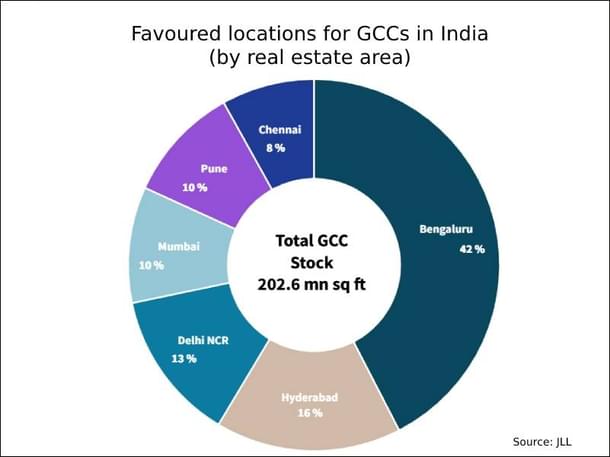Tech
Global Capability Centres — Why India Has Emerged As The Most Favoured Destination
Anand Parthasarathy
Aug 17, 2023, 12:22 PM | Updated 04:29 PM IST
Save & read from anywhere!
Bookmark stories for easy access on any device or the Swarajya app.


In the early 2000s, India became the favourite offshore destination for Business Processing Outsourcing (BPO), otherwise known as call centres by the average middle-class household.
Multinational companies across the world, ranging from AOL to MSN, looked at India to capitalise on language proficiency and process intelligence, to drive global customer support.
Suddenly, new coaching classes and finishing schools mushroomed across the length and breadth of the country, and night shift jobs became the new normal. This was probably the first instance of the world turning to India for critical IT-driven assistance.
Two and a half decades later, India is monopolising the world in creating tech-enabled solutions to solve global problems end-to-end. Staying true to its target of becoming a $5 trillion economy soon, India is leading the way today in unlocking innovation by becoming a global hub for Global Capability Centres (GCCs)
End-to-end innovations fuelled by GCCs
The fundamental difference between BPO and GCCs is that BPOs let you leverage your proficiency in specific, mostly narrow fields, while GCCs allow the brain-force of the country to continuously create value and make an impact through end-to-end innovation.
This in turn presents India with the opportunity to uncover new discoveries and become a one stop shop for high-end tech-enabled innovation.
According to a recent survey by Axis Capital (India Strategy Report, 7 August 2023), the number of GCCs in India have doubled between 2012 and 2023, the GCC headcount has increased by 280,000 in just the first half of 2023.
Today, more than 17 lakh employees work in GCCs, making the sector as big if not bigger than tier-1 IT companies, with a Compounded Annual Growth Rate (CAGR) of 12.1 per cent between 2018 and 2023.
The Axis Cap report also reveals that “all companies are now tech companies”, and are fuelled by frugal innovation, local market access and end-to-end business process ownership.
Multiple global surveys reaffirm the fact that GCCs have truly arrived in India, with long-term strategies and goals. According to a release from professional services and real estate leader, JLL , India is home to more than 1,800 global capability centres which is expected to grow to around 2,300 by 2025.
The study finds that technology firms and Banking, Financial Services and Insurance (BFSI) lead leasing demand from GCCs. account for around 64 per cent of the GCCs.
While tech still dominated, more high-end R&D work in BFSI, new technologies like AI/ML, Engineering/Manufacturing, Data Science and robotics were key to the new GCC demand in the country.

JLL’s GCC guide 2023 says: “Cities like Bengaluru, Hyderabad, Delhi NCR, Mumbai, Pune, and Chennai are the most popular destinations, offering a conducive environment for global capability centres in India, with their robust infrastructure, access to talent, and supportive ecosystem”.
These centres have played a significant role in India's economic growth, providing high-quality employment opportunities, and contributing to the country's GDP.
These GCCs, that represent global companies in India, are spread across sectors including technology, engineering, consulting and many more. In fact, the country’s large pool of talented and skilled professionals, cost-effectiveness, and supportive government policies have made India the preferred destination for many such innovation hubs.
The survey also reveals that government impetus and support, together with availability of high-quality talent pool, facilities and technology infrastructure, and cost-effectiveness compared to the West, is truly fuelling the growth of GCCs in India.
Proof of this lies in the reality that 50 per cent of the world’s GCCs are operating out of India, resulting in India housing the largest cluster of Fortune 500 GCCs in the world.
Opportunity to unlock new industry verticals
According to NASSCOM, GCCs are now focusing on high value activities such as IP-creation, building competencies around emerging technologies, setting up COEs and taking full ownership of vendor management.
There are increasing cases of Indian GCC leaders having global roles and the GIC governance model is more accountability-driven. GCCs have also integrated deeper into the Indian ecosystem by forging partnerships with start-ups, universities and service providers.
Apart from this, GCCs have also taken up the digitisation mandate for their parent firms–helping the parent evolve to a fit-for-future digital enterprise. NASSCOM has also listed out the next phase of growth for GCCs in India, and these include capturing newer industry segments and diversifying competencies, fast-tracking the process of creating leaders, collaboration and networking, among others.
Fourth Wave coming
Global consulting firms like E&Y and Deloitte are helping global companies by providing blueprints and visions to unlock values through India-based GCCs, adding to the momentum from the government. The latest (June 2023 edition) of the NASSCOM-Zinnov biennial report on the GCC India Landscape titled ‘GCC 4.0: India Redefining the Globalization Blueprint’, suggests: “ GCCS are increasingly maturing in a 4th wave, as they leverage scale, innovation, delivery excellence and leadership which lies at the core of India’s GCC progression”.
“India is at the epicentre of the GCC 4.0 wave, where India GCCs and their leaders are redrawing the blueprint of globalization by going beyond a cost and scale retrospective,” said Pari Natarajan, Chief Executive Officer of Zinnov. “They are helping their HQs solve new problems across business, technology, and people”.
Zinnov believes that by 2025 India-based GCCs will employ 2 million people and be worth $60 billion in market size (it is currently worth $46 billion).
Enabling a recession proof future
Amidst threats of world-wide business turbulence, India is staying afloat and resilient, insulating itself from global slowdowns, even while emerging as a crucible in the arena of global capability centres.
On 16 August, in an interview in Financial Express, Mark Papermaster, Chief Technology Officer of semiconductor products leader AMD said: “The India team plays a role in the design of nearly every AMD chip across our diversified portfolio in high-performance CPU, server, data centre GPU, gaming graphics, PC, adaptive computing and embedded devices”.
More is expected: Soon to come up in Bengaluru is AMD’s largest ever 500,000 sq ft design centre for which the company has earmarked $400 million.
For AMD and so many others, the GCC story goes on…
Anand Parthasarathy is managing director at Online India Tech Pvt Ltd and a veteran IT journalist who has written about the Indian technology landscape for more than 15 years for The Hindu.





